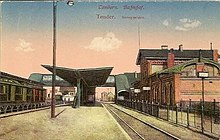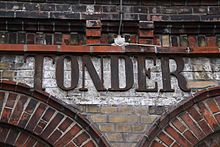Tønder train station
| Tønder Tondern |
|
|---|---|
|
Platform with railcars from Arriva and NOB (2004)
|
|
| Data | |
| Design | Through station |
| Platform tracks | 2 |
| abbreviation | Tdr |
| opening | October 17, 1887 |
| location | |
| City / municipality | Tønder |
| region | Syddanmark |
| Country | Denmark |
| Coordinates | 54 ° 56 '0 " N , 8 ° 51' 38" E |
| Height ( SO ) | 2 m |
| Railway lines | |
| List of train stations in Denmark | |
The Tønder Station ( Danish Tønder Station , German Railway Station Tonder ), from the 1940s up to the May 28, 1972 Tønder Hovedbanegård ( German Tonder Hauptbahnhof ), a Danish border station in the town Tønder in South Denmark near the German border. It is located on the Marschbahn , on the Bramming – Tønder railway and on the former Tønder – Højer Sluse and Tønder – Tinglev railway lines .
history
First years in Germany
Tondern received its first rail connection in 1867 with the opening of the Tondern – Tingleff railway line , which was built by the Peto, Brassey and Betts consortium . The train station in the north of the city was a terminus. The station was later referred to as Stadt-Bahnhof (St-Bhf ). In 1914 this station was called Nord-Bahnhof . During the Danish period, the name was changed to Tønder Øst , the station name Tønder Nord was given for a later-built stop on the Bramming – Tønder railway line .
In the course of the extension of the march line from Niebüll to the then state border at Hvidding ( Danish: Hviding ), the march station (M-Bhf) (today Jernbanegade 8) was opened on November 15, 1887 by the Glückstadt-Elmshorn Railway Company . The branch line from Tingleff was introduced into the new station, which was located a little north of the current railway facilities.
With the nationalization of the private railway company, renamed Schleswig-Holsteinische Marschbahn-Gesellschaft in 1888, on July 1, 1890, the Prussian State Railways took over the operation. In the following years they made extensive extensions to the railway facilities. Reception building, depot and goods handling were rebuilt. The access to the platforms was equipped with an overpass. The old station building of the Marschbahn was rebuilt and continued to operate as Eichlers Hotel .
On June 15, 1892, the connection to the Hoyerschleuse ( Danish Højer Sluse ) with a ferry connection to the island of Sylt was put into operation.
The new station is sometimes also called Marschbahnhof Tondern ( Danish Tønder Marskbanegården ).
Takeover by the Danish State Railways
In 1920, the German Reich had to cede North Schleswig to Denmark as a result of the referendum provided for in the Versailles Treaty . The railways in this area were taken over by the Danish State Railways from then on . This had serious consequences for the importance of Tønder station, as it has been called since the takeover, because traffic over the new state border almost four kilometers south of the station initially came to a complete standstill.
From 1921 passport-free and duty-free corridor traffic was set up for the bathing trains to Sylt . The wagons were sealed by customs in Süderlügum and were not allowed to leave as far as Højer Sluse. From 1924 the customs clearance of goods wagons to Germany took place in Tønder and in the opposite direction in Süderlügum. The wagons were delivered by shuttle trains between Süderlügum and Tønder; there was no longer any through traffic. Travelers to Westerland took these trains in sealed passenger cars to Tønder, where they could change to the train to Højer Sluse under guard, but without passport and customs control.
With the opening of the Hindenburg dam in 1927, the corridor traffic ceased, which led to a sharp decrease in traffic in Tønder. The Niebüll – Tønder line has been downgraded to a branch line .
Passenger traffic to Højer Sluse was stopped on May 15, 1935, freight trains to Højer continued until March 31, 1962.
World War II and after
In Denmark, the main train station in cities with several stations was in the 1940s isolated as Hovedbanegård designated with the code letter H provided. These were Haderslev H from 1943 to 1968, Vejle H until May 23, 1971, Skive H, Tønder H, Nyborg H and Sønderborg H until May 28, 1972, and Rønne H until its closure.
The passenger traffic to Tinglev ( German Tingleff ) was operated until 1971, it mostly had only local significance. Between 1948 and 1966 there was a direct railcar connection between Sønderborg and Tønder. Freight traffic took place until 2001.
Already during the Second World War there was little cross-border traffic in Tønder, in 1944 only three pairs of trains ran between Niebüll and Tønder.
On April 15, 1945 the station was the target of an air raid. A bomb hit the Marschbahn Hotel, which at the time was serving as a refugee camp.
After the Second World War, a few passenger trains from individual through coaches ran on the Hamburg– Esbjerg route only seasonally . When this through car connection was discontinued, cross-border traffic was given up in 1981. Freight trains only ran from Germany to Süderlügum.
Since 2000
After a few test drives in 2000, the Nordfriesische Verkehrsbetriebe AG (NVAG) drove from Niebüll to Tønder every two hours from 2001, where there was a connection to the Danske Statsbaner trains to Esbjerg. From 2003 the Nord-Ostsee-Bahn (legal successor to the insolvent NVAG) operated the route with an NE 81 , and trains from Arriva Danmark , a subsidiary of Deutsche Bahn , also ran on the Danish side . Since December 12, 2010, trains have been running from Arriva to Niebüll, so there is a continuous connection between Esbjerg and Niebüll. Since December 14, 2014, the trains have been referred to as " RB 66" by the German side .
Railway systems
Tønder station is designed as a through station, the main tracks of the march line run roughly in a north-south direction. The lines to Tinglev and Høyer Sluse branched off at the northern head of the station.
passenger traffic
The present reception building was built after the nationalization and consists of a main building with two large side wings, which were raised to the height of the main building in later years.
There were four platform tracks for passenger traffic, which could be reached from the house platform and two island platforms with short roofs at the height of the reception building. Today only the western island platform with two platform edges is still in operation, the other tracks have been dismantled.
Freight transport
Tønder had extensive track systems for local freight traffic. General cargo was handled in the goods shed south of the reception building; the loading street was in the same area. Live cattle were transshipped at the cattle loading ramp and cattle bays on the western side of the station; there was also a siding and storage area. A weighbridge and a head and side ramp were available. All systems are out of operation and for the most part dismantled or used for other purposes. From Tønder, sidings of several industrial companies in the north and south of the city are still served.
Depot
The depot was located at the southern head of the station and consisted of an eleven round locomotive shed with a turntable , water tower , coal store and locomotive treatment systems. The two-tier workshop was attached to the circular shed and connected via the turntable. The locomotive shed still exists ( map ), the remaining facilities in the depot have been completely dismantled.
business
The following connections exist from Tønder:
| Line (german) |
Line (danish) |
Line route | operator | Tact |
|---|---|---|---|---|
| RB66 | Local bane | Esbjerg - Bramming - Ribe - Skærbæk - Bredebro - Tondern / Tønder - Niebüll | Arriva Danmark | 60 min. To Niebüll, except in the afternoon, only every 120 min |
Web links
- Strækningsoversighter. (PDF) TIB-S. Banedanmark , September 26, 2016, p. 648 , accessed on September 26, 2016 (Danish, current track plan of the station).
- ESBJERG> NIEBÜLL. (PDF) Gyldig December 15, 2019 to December 12, 2020. Arriva Danmark, December 15, 2019, accessed March 24, 2020 (Danish).
- Private website for Tondern / Tønder u. a. with pictures
- Course book table railway line Hamburg – Tondern – Hoyer u. Hvidding from 1914
Individual evidence
- ^ A b c Henrik J. Møller: Tønder Banegård. with photos of the station and the depot. In: HistoriskAtlas.dk. Retrieved March 23, 2020 (Danish, original sources: JP Trap Danmark 5. udg.Tønder Amt, Vol. X, 2 Hans Bachmann m.fl .: Tønders gamle kroer og gæstgiverier, Tønder 1995.).
- ↑ a b Prussian map around 1880 (year not quite certain, composite map with pages up to 1892) at HistoriskAtlas.dk
- ↑ South Schleswig map from 1929 (year not quite certain) at HistoriskAtlas.dk
- ↑ Course book table Sonderburg – Törsbüll – Flensburg u. Tondern. In: Hendschels Telegraph. 1914, Retrieved January 4, 2015 .
- ↑ Henrik J. Møller: Marskbanegården. In: historiskatlas.dk. Retrieved on January 4, 2015 (Original source: Hans Bachmann m.fl .: Tønders gamle kroer og gæstgiverier, Tønder 1995).
- ^ Danske hovedbanegårde. October 3, 2011, archived from the original on January 3, 2015 ; Retrieved September 26, 2016 (Danish).
- ^ Deutsche Reichsbahn (Ed.): German course book - annual timetable 1944/45 . Berlin 1944, p. 27 ( online ).
- ↑ Death entry of Dieter Willi Werner. In: Family research in West Prussia. May 2014, accessed on January 2, 2015 : “Last place of residence: Tønder refugee camp (Jernbanegade 8). Cause of death: Killed by a bomb in Jernbanegade 8 in Tønder. "
- ↑ Tønder 1952. (JPG) track plan. March 1952, accessed January 1, 2015 (Danish).






